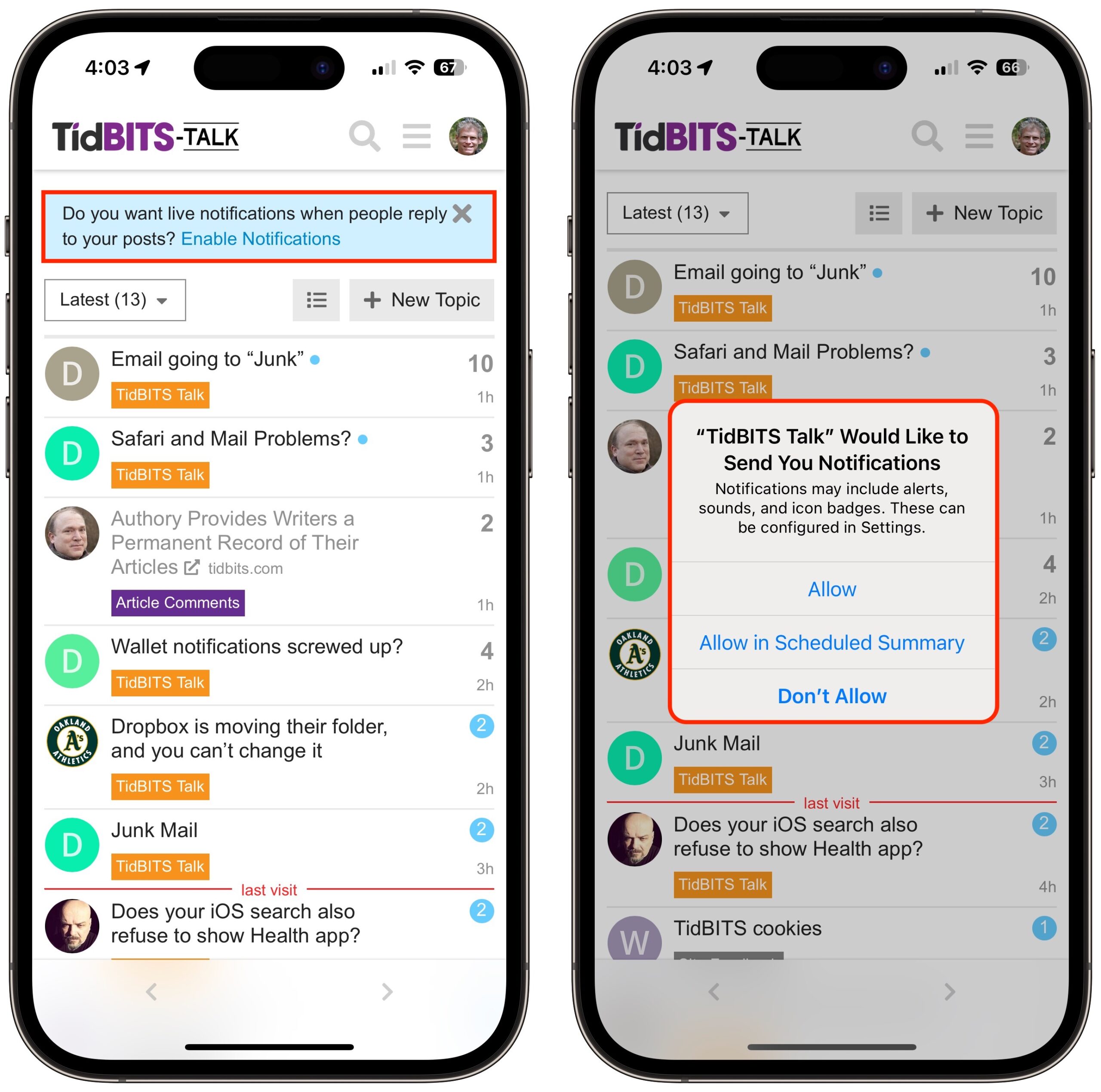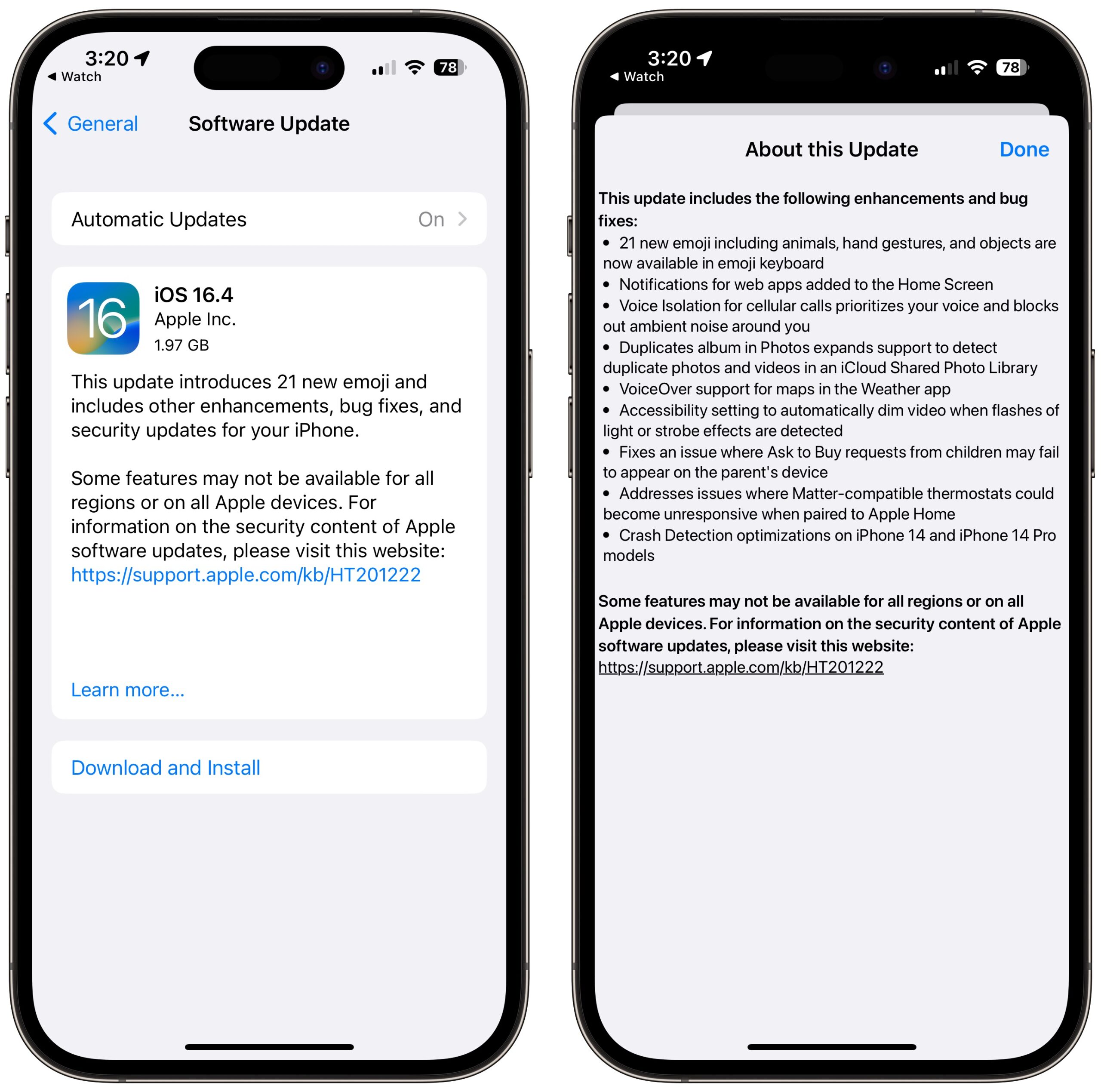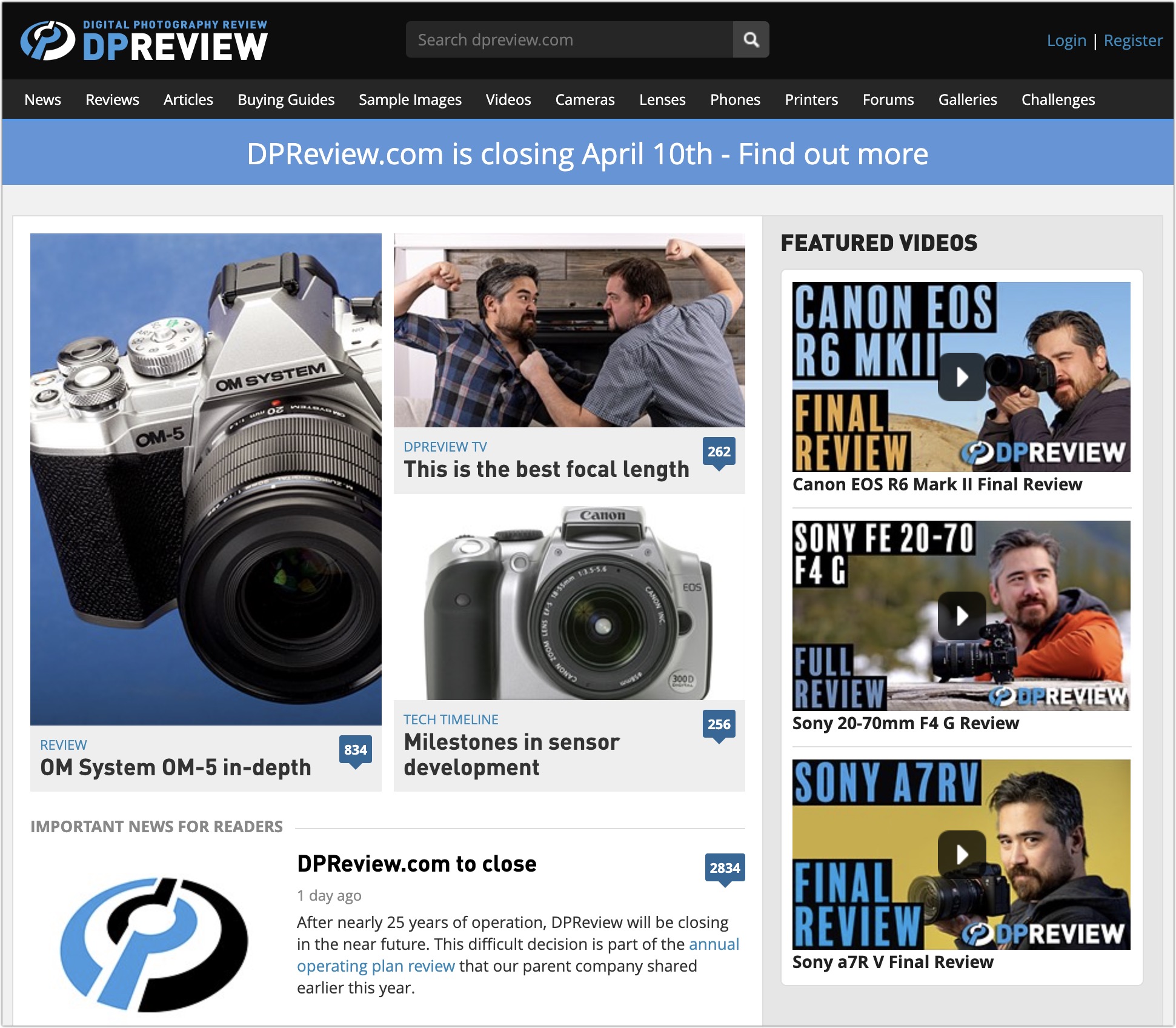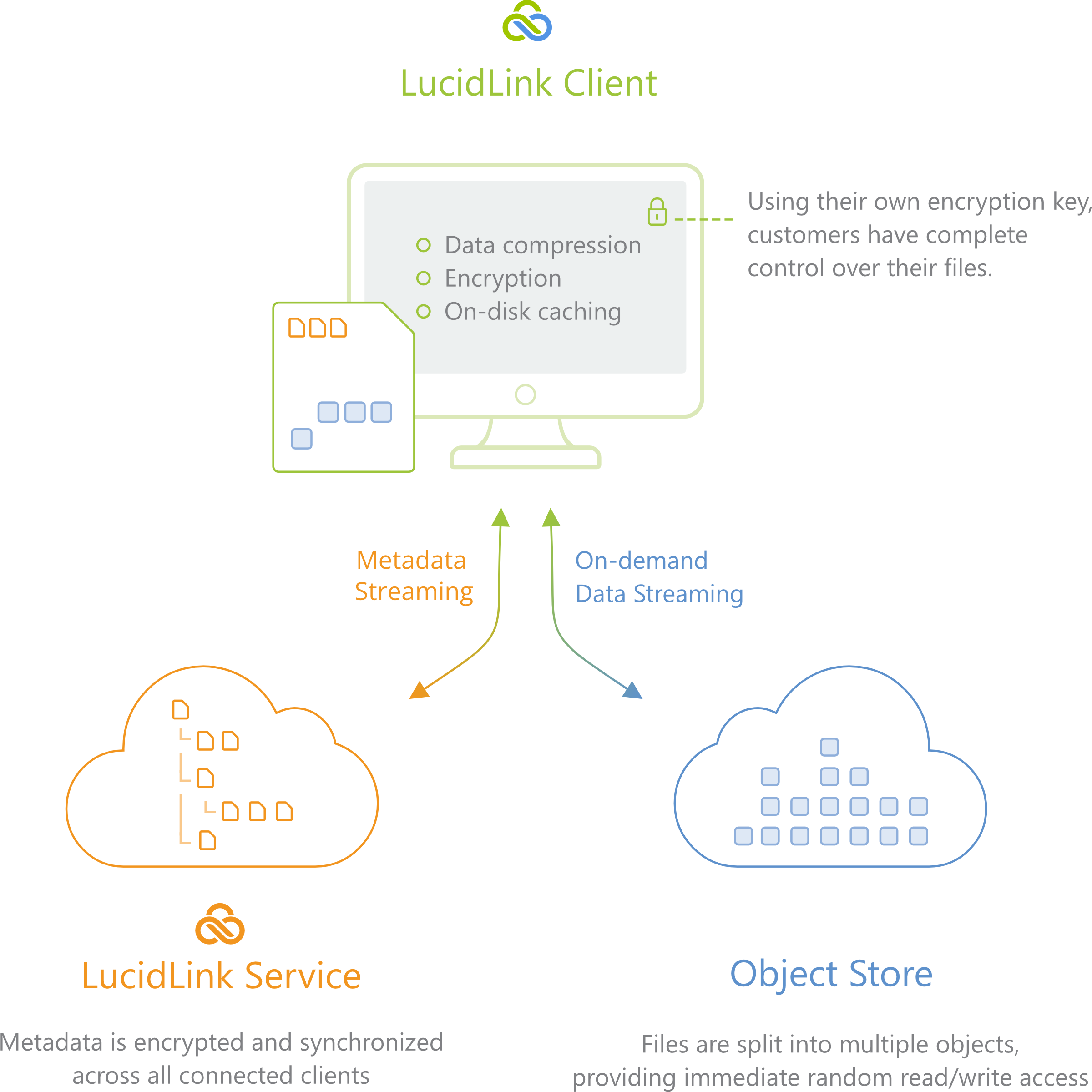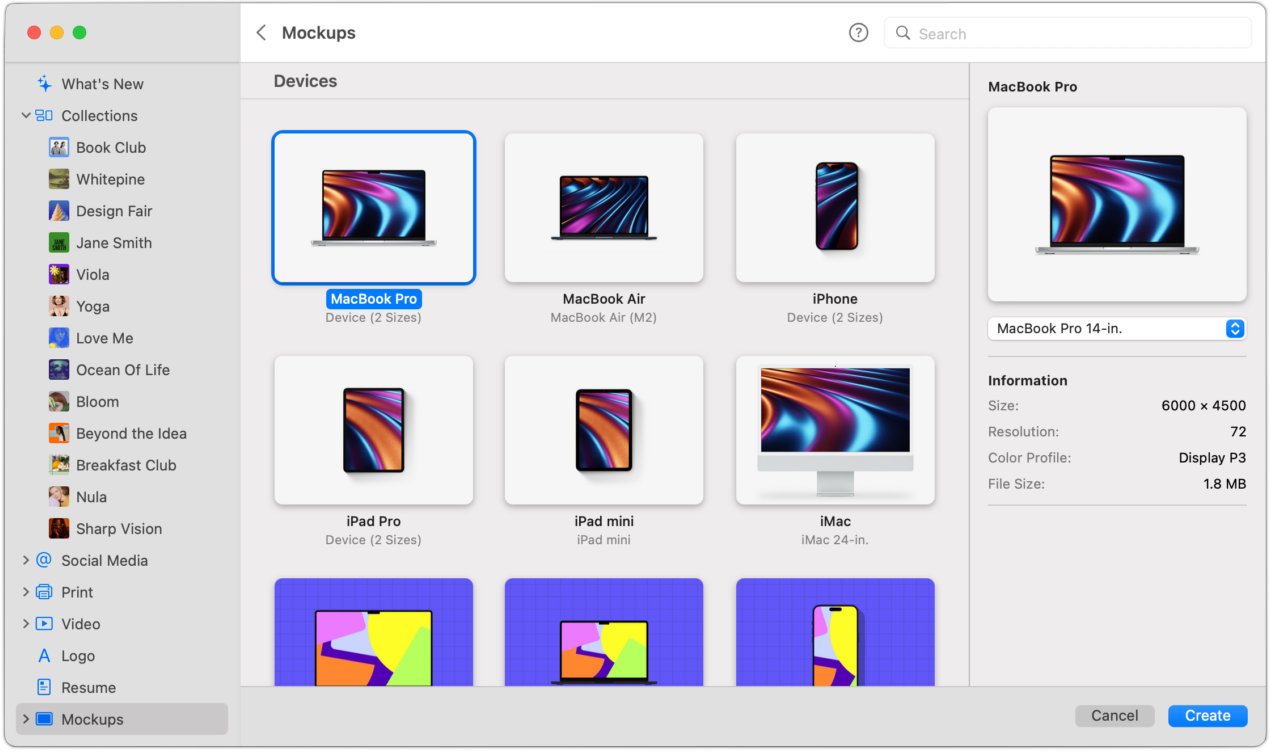#1652: OS updates, DPReview shuttered, LucidLink cloud storage
It’s update day again, with Apple releasing minor feature updates to all its current operating systems with improvements in iPhone voice quality and crash detection, duplicate checking in iCloud Shared Photo Library, notifications for Web apps added to the Home Screen, and more. There are also security updates for the older iOS 15 and iPadOS 15. Sad news—the venerable photography website DPReview is shutting down, the victim of corporate parent Amazon’s cost-cutting measures. Professional photographer Jeff Carlson pays his respects to a site that has been the Internet’s go-to source for camera and lens reviews for decades. Finally, Adam Engst looks at LucidLink, an innovative cloud-storage service that breaks from the Dropbox mold to provide direct, rather than synced, access to cloud-native data. Notable Mac app releases this week include macOS Monterey 12.6.4 and Big Sur 11.7.5, Safari 16.4, Pixelmator Pro 3.3.2, Zoom 5.14, and Default Folder X 5.7.6.
Apple Releases iOS 16.4, iPadOS 16.4, macOS 13.3 Ventura, watchOS 9.4, tvOS 16.4, and HomePod Software 16.4
Is it weird that Apple’s release notes for iOS 16.4, iPadOS 16.4, and macOS 13.3 Ventura lead off with the fact they include 21 new emoji? The only appropriate response is to channel my inner teen by rolling my eyes and muttering, “Whatever.”
Apart from that, these updates, along with watchOS 9.4 and tvOS 16.4, provide some features that are welcome, if not world-changing, for most users. Unsurprisingly, HomePod Software 16.4 merely “includes performance and stability improvements.” I hope it addresses an increasingly common problem with our first-generation HomePods that causes them to go silent for a second or two before resuming playback.
If some of the changes I describe below sound compelling, I see no reason you should delay updating. On the other hand, if you would be doing so just to stay current with Apple’s security fixes, none of which are being exploited in the wild, you can wait a week to ensure there aren’t any unanticipated side effects.
Shared Changes
Many of the changes apply to two or more of Apple’s operating systems.
For some people, Apple’s “Notifications for web apps added to the Home Screen” may be extremely welcome, but it requires some unpacking. There’s a W3C standard that enables websites to generate notifications outside the context of a page, and you’ve probably run across sites that ask to send you notifications. Although Safari—along with Brave, Chrome, Firefox, and Microsoft Edge—supports Web Push, that has been true only on the Mac until now.
With iOS 16.4 and iPadOS 16.4, Web apps you add to your Home Screen (tap Share, scroll down, and tap Add to Home Screen) can now display native notifications. That’s a big deal for Web apps like Discourse, the software we use for TidBITS Talk. Before this, it couldn’t trigger notifications of new posts on an iPhone or iPad. Notifications of TidBITS Talk messages might be overkill for most people, but I also use Discourse for the low-traffic Finger Lakes Runners Club discussion forum, where I do want to see immediate notifications.
Another welcome change in iOS 16.4, iPadOS 16.4, and macOS 13.3 is expanded support for duplicate-checking in Photos. The Duplicates album now detects duplicate photos and videos in an iCloud Shared Photo Library.
If you’ve wondered about those warnings about flashing lights before movies or TV shows, they exist to alert those with photosensitive epilepsy or other photosensitivity (such as a migraine trigger) that they should be careful. Apple has now gone further with iOS 16.4, iPadOS 16.4, macOS 13.3, and tvOS 16.4 with an accessibility setting that automatically dims video when flashes of light or strobe effects are detected. Look for Settings > Accessibility > Motion > Dim Flashing Lights on the iPhone and iPad, and in System Settings > Accessibility > Display on the Mac. On the Apple TV, I would expect the setting to appear in Settings > Accessibility > Display or Motion, but I can’t find it. Suggestions welcome.
All three of the major operating systems now provide VoiceOver support for maps in the Weather app.
Apple also fixed two bugs that affected the iPhone, iPad, and Mac. Ask to Buy requests from children could previously fail to appear on the parent’s device, no doubt causing gnashing of little teeth. Those with Matter-compatible thermostats probably weren’t happy when their thermostats became unresponsive after being paired to Apple Home. Brr!
iPhone-only Changes in iOS 16.4
Perhaps most importantly, Apple says iOS 16.4 optimizes the Crash Detection algorithms for the iPhone 14 and iPhone 14 Pro models. We’re at the tail end of the skiing season, but with luck, Apple will have eliminated the inaccurate warnings inundating emergency services near ski resorts. As we head toward summer in the US, we hope Apple also addressed similar problems at amusement parks (see “Roller Coasters Can Trigger Crash Detection in the iPhone 14 and Apple Watch,” 10 October 2022).
Although you might not notice this change, installing iOS 16.4 will give you Apple’s Voice Isolation feature for regular cellular calls (it was previously available only for FaceTime audio). It uses machine learning to block ambient noise and prioritize your voice. It should make you sound better to the people you call. I can’t find any switches for it in iOS 16.4—I presume it’s on by default.
Last and definitely least, in a fix I am inordinately fond of, Apple has finally figured out how to get the iOS release notes to display at a readable font size.
iPad-only Changes in iPadOS 16.4
Once again, Apple hasn’t done much that focuses on the iPad. The only two iPad-specific changes revolve around the Apple Pencil, with one new feature and one bug fix.
For those with the fourth-generation 11-inch iPad Pro and sixth-generation 12.9-inch iPad Pro, Apple Pencil hover adds tilt and azimuth support so you can preview your mark at any angle before you make it in Notes and supported apps.
And for everyone else with an Apple Pencil, iPadOS 16.4 fixes a problem with responsiveness that could occur while drawing or writing in Notes.
Mac-only changes in macOS 13.3
The only Mac-specific feature in macOS 13.3 Ventura is the option to remove backgrounds in Freeform to isolate the subject in an image. Useful, I suppose.
Apple also added transliteration support for Gujarati, Punjabi, and Urdu keyboards—possibly indicating more focus on India as Apple looks to increase sales and manufacturing in the country. The new keyboard layouts for Choctaw, Chickasaw, Akan, Hausa, and Yoruba are probably just about doing the right thing in supporting Native American and African languages.
Finally, macOS 13.3 fixes a pair of bugs: one that could prevent trackpad gestures from working and another that caused VoiceOver to become unresponsive after using the Finder.
watchOS 9.4
watchOS 9.4 receives only one general improvement: wake-up alarms are no longer silenced with the cover-to-mute gesture because it was too easy to cancel the alarm accidentally while asleep.
The remaining changes are location-specific. Cycle tracking with retrospective ovulation estimates and cycle deviation alerts is now supported in Moldova and Ukraine. Also, AFib History is now available in Colombia, Malaysia, Moldova, Thailand, and Ukraine.
Security Updates
As usual, there are numerous security updates. I suppose we should be grateful that Apple is addressing so many vulnerabilities, but it would be nice if there were fewer to start. Happily, Apple doesn’t identify any of these as being actively exploited in the wild.
- iOS 16.4 and iPadOS 16.4: 32 vulnerabilities
- macOS 13.3: 49 vulnerabilities
- watchOS 9.4: 16 vulnerabilities
- tvOS 16.4: 14 vulnerabilities
If you experience any issues with these updates, let us know in the comments!
iOS 15.7.4 and iPadOS 15.7.4 Provide Security Fixes
There isn’t much to say here, but Apple has released iOS 15.7.4 and iPadOS 15.7.4 with fixes for 16 security vulnerabilities. The company says that one bug, a WebKit vulnerability that opens iPhones and iPads up to maliciously crafted Web content, is actively being exploited in the wild. As such, we recommend updating older devices that can’t run iOS 16 right away.
Amazon Shutters Photo Resource Website DPReview
After 25 years, it’s studio-lights-out for DPReview.com.
The venerable photography site (DP stands for Digital Photography) announced it will close on 10 April 2023, at which point its content will be “available in read-only mode for a limited period afterwards.” That content includes deep-dive reviews of camera bodies and lenses, plus articles covering all aspects of the field of photography. It’s an unmatched resource of photo information.
Why now? Unlike most sites, DPReview didn’t rely on scores of ads to survive. Amazon acquired DPReview in 2007 and largely left it as an independent outfit, to the point where many people weren’t aware of its corporate ownership. In addition to a few ads, DPReview received affiliate income when someone purchased products (even though DPReview and Amazon were under the same umbrella), and the site also occasionally featured sponsored content, such as videos about new cameras. Bucking trends, all third-party content was always clearly marked and above-board.
Unfortunately, being owned by Amazon is what ultimately killed DPReview. The day before the announcement, Amazon revealed it was laying off 9,000 employees on top of the 18,000 let go since November 2022. The retailer is also shedding other services to cut expenses, such as its Kindle Newsstand online and print magazine subscription service. DPReview wrote, “This difficult decision is part of the annual operating plan review that our parent company shared earlier this year.”
DPReview also boasts an enormous discussion forum where readers have formed a thriving community with over 47 million posts in upwards of 4 million threads. Forum members can request to download any photos or text they’ve uploaded, but only until 6 April 2023, which is fast approaching.
The wording of the announcement suggests that the site’s content and forums will be deleted at some point after the “limited period” following the April 10th shutdown; when I reached out to verify that interpretation, a source I spoke with at the company didn’t know what would happen. A separate source told me that the site’s engineers have been working to make the site exportable and coordinating with the Internet Archive to preserve the content. According to a post on Reddit, the Internet Archive’s Archive team is actively working on archiving the site. We hope they succeed in capturing everything.
Another casualty of the shutdown is the popular DPReview TV YouTube channel featuring Chris Niccolls and Jordan Drake. However, a few hours after the DPR news dropped, PetaPixel announced that it would serve as the new home for the duo beginning in May.
This is all disappointing news for many reasons, not just because I’ve been a contributor since 2017. My most recent piece, Pete Souza: In the West Wing and Beyond, was an interview with noted White House photographer Pete Souza when he was on a book tour.
DPReview was one of the Web’s few definitive resources. If you were in the market for a new camera or lens, or were looking to buy an older model, you could find exhaustive, objective, well-tested information about it. Online retailers (particularly parent company Amazon) include scores of reviews of dubious accuracy and provenance, and search engines are next to useless for trying to find reliable information. DPReview has been so good on this front that many photo sites opted not to publish in-depth gear reviews because they knew DPReview would have it covered.
I honestly can’t suggest an alternative site that even approaches DPReview’s level of detail about photography. It’s a loss for consumers and for the communities that spring up around photography. It’s also a stark reminder that corporate ownership, far from being a safe haven, may increase the likelihood of a popular site disappearing. As longtime online publisher Derek Powazek wrote on Mastodon, “Moral of the story: don’t sell your site to a tech behemoth that will only ever see you as an annoying line item.”
LucidLink Offers Streaming Vision of Cloud-Based Storage
When I was deep in researching details related to Dropbox migrating to Apple’s File Provider extension (see “Apple’s File Provider Forces Mac Cloud Storage Changes,” 10 March 2023), I was intrigued to see comments from people in the media world, where I have little experience. These folks inhabit an entirely different digital reality from everyday users who are happy with 1 TB of internal storage. User millifoo wrote:
We use cloud sync with our external huge drives to allow collaboration with audio/video editing. The workflow for lots of media houses with people who collaborate in multiple locations requires files be local (speed of editing and playback), and sync through the cloud not only facilitates that, it also backs up all the files in case of catastrophe.
Others noted that Dropbox’s plans don’t provide enough storage. The Plus and Family plans include 2 TB, the Professional plan is 3 TB, and the Standard team plan comes with 5 TB. Only the Advanced plan, at $24 per user per month, allows for more storage. How much do these media folks need? KyleKoch noted:
There are many of us who require Dropbox to be on external drives when media is local. The logistics to manage video assets within a Dropbox folder located on the OS drive does not make any sense when you have a 50TB+ of cloud storage.
User solldavid concurred:
We have the advanced plan and are up to 200+ TB of assets in the Dropbox cloud, all visible and searchable in OSX Finder via “online-only”, and restorable with a full bandwidth download. It’s the best product in the industry imo. Yes, you need a minimum of three “users”.
Unfortunately, on topic with the thread, this change from Apple and Dropbox threatens my whole workflow. We keep 3-6TB available offline at a time to keep large video, GFX, and 3D files in sync across remote workstations, and we’ve been doing it with external SSDs successfully since 2012. It’s been the cornerstone of our workflow, super reliable, plenty fast, and I don’t know what I would have done without it.
And user jmeredi2 said:
We have a business advanced plan with 6 users that we pay about $1,700/ year for. This is an unlimited plan, so every time we reach our storage limit, they give us more space. Unfortunately this obviously won’t work anymore with the DropBox “upgrade” unless I can find computers with 30-40 TB internal hard drives.
I recognize that many people require more than a terabyte or two of cloud storage, but these comments gave me a peek into professional media demands. I share this as context because soon after my article appeared, I heard from TidBITS reader Steven Niedzielski about how LucidLink, the company he works for, provides streamed cloud storage for high-performance media users. I was curious to learn more, even if the system is overkill for most of the rest of us.
LucidLink Rethinks Cloud Storage
The backdrop to my previous article was Apple’s File Provider extension, which offers a coherent approach for “sync-and-share” services like Box, Dropbox, Google Drive, and Microsoft OneDrive.
They all rely on an architecture that’s relatively simple, conceptually speaking. All your files are stored online and can be accessed via a Web interface. Client software for different operating systems syncs that data store to devices, either with full content (offline) or in placeholder form (online-only). If you need to work on an online-only file, it must be downloaded in its entirety before you can access it. Changes, including additions, deletions, and adjustments to the directory structure, are synced from a client first back to the cloud and then down to all the other connected clients. Some of those changes may rely on a diff approach, where only the changed bits of a particular file need to be transferred; in other cases, the entire file must be sent back.
LucidLink doesn’t work that way. On the Mac, it leans on MacFUSE to mount LucidLink’s proprietary Filespace cloud-native file system as a standard Mac volume. (LucidLink is also available for Windows and Linux.) Think for a moment about that. You interact with what looks like a normal external or network drive in the Finder, but what’s behind it is data in a cloud-native file system. Thus, opening a file from LucidLink works in the same way as opening a file from a Mac’s internal SSD, though it reads and writes data in blocks of 256 kilobytes, whereas the default block size for macOS local storage is 4096 bytes.
That means LucidLink has no need to sync a file in its entirety before opening it, as would be the case for an online-only file in Dropbox, say. With small files, the syncing approach works well enough, but with the size of files used in the media world, retrieving a file from the cloud takes significant time—hence the need for large external drives to store local versions.
I’ve long thought MacFUSE was a brilliant way to integrate unusual file systems into the Mac experience, so I understood what LucidLink was doing. However, I immediately asked Niedzielski how much bandwidth LucidLink needed, expecting him to admit that a 1 Gbps fiber connection was necessary and that serious video professionals all had such connectivity.
Instead, he said that 50 Mbps down and 10 Mbps up was a realistic minimum for non-video work. In an ideal video world, he noted that you’d want to match the bandwidth of your video stream for seamless behavior. I don’t think of video in terms of bandwidth, but I suspect that the more you have, the better—that fiber connection might be a good idea. One hands-on review said that LucidLink worked well with 230 Mbps down, though that was seemingly in a proxy workflow scenario, where most edits involved smaller proxy files. Low latency is also important, and LucidLink’s interface reports on that (also see “Use Apple’s networkQuality Tool to Test Internet Responsiveness,” 22 April 2022).
Important though bandwidth is, anyone using Dropbox or a similar service will have to store all that data locally anyway. LucidLink also relies on a fast local cache to improve performance. It defaults to 5 GB on the internal drive, but you can repoint it to an external drive and increase it to 10 TB. Plus, if you know you will be working on certain files, you can “pin” them to pre-load them into the local cache. Even with pinned files, LucidLink uploads only diffed data at the block level, so it doesn’t have to transfer entire files for small changes.
One downside to LucidLink’s approach is that you cannot work offline, even with pinned files. Because it has a single source of truth in the cloud, users need to maintain Internet connectivity for the service to work. The local cache is just that, a cache, not an independent copy of files.
There’s another downside of sorts to LucidLink’s caching approach. Some Dropbox users see the “sync-and-share” architecture as providing a backup. It’s not, of course, since any user with appropriate permissions can inadvertently or maliciously delete files, but you do end up with multiple copies in most situations. LucidLink’s local cache doesn’t provide even that.
However, LucidLink’s Filespace file system offers automatic snapshots, just like APFS. (Some LucidLink plans let you create custom snapshot schedules.) Snapshots record the exact state of your files at that point in time, making it easy to recover deleted, corrupted, or changed files. They use space efficiently, recording only the block-level data that has changed between two snapshots. Even better, snapshots are read-only, so they also provide a defense against ransomware attacks that attempt to destroy backups.
Nonetheless, LucidLink encourages backups. Niedzielski said that the company considers LucidLink a “hot active collaboration space” and recommends that users maintain a separate copy of all files. That could be on a local NAS device or in the cloud to a service like Backblaze B2 or Wasabi. He also mentioned that some clients rely on a data management service called CloudSoda to migrate and protect their LucidLink data—we’re talking about serious enterprise-level capabilities here.
There’s no question that LucidLink is aimed at the business world, whether media houses, medical imaging groups, or game development teams. Even the US Department of Treasury is a LucidLink customer. And if you’re hesitant about paying $9.99 per month for 2 TB of storage from the likes of Dropbox, Google Drive, or iCloud Drive, LucidLink is overkill.
But it’s not out of the question. LucidLink’s Basic Filespace plan costs $20 per terabyte per month for up to five users—additional users each cost $10 per month. That’s twice as much per month for half the storage with a consumer-level service, which is expensive but manageable for a freelancer or small office. The Advanced Filespace plan costs $80 per terabyte per month, again with five users, but uses IBM storage rather than Wasabi storage for higher performance, provides custom snapshot schedules, and offers single sign-on integration.
It’s worth noting that there are actually three parts to LucidLink: the LucidLink Client running on your Mac, the LucidLink Service that manages the metadata and snapshots, and the Object Storage, which is any S3- or Azure-compliant storage system. That explains the Custom Filespace plan, which is just $40 per terabyte per month but lets you provide your own storage. However, the Wasabi and IBM storage in the other plans doesn’t come with egress fees, which most cloud storage providers charge to retrieve data. With a lot of data access, egress fees could add up quickly and unpredictably.
From a security standpoint, LucidLink claims a “zero-knowledge” approach. The LucidLink Client provides end-to-end encryption, with only the user holding the encryption keys. Plus, the LucidLink Service never sees your data, just its metadata, and the data at the storage provider is encrypted at rest. It seems very well thought-out.
There’s no reason to switch to LucidLink from the likes of Dropbox, Google Drive, or iCloud Drive if all you need is cloud storage and basic collaboration. However, if you’re pushing against the limitations of those services, particularly with audio or video work, LucidLink is worth a look.
More generally, I’m pondering whether there’s a larger role for streamed online storage that looks and feels like local storage. Free space concerns could become a thing of the past if our devices could access theoretically unlimited amounts of storage online at any time. Caching would still be useful for performance reasons and possibly for eliminating the need for constant connectivity, but we’d always have as much storage as we needed… and were willing to pay for, of course.
